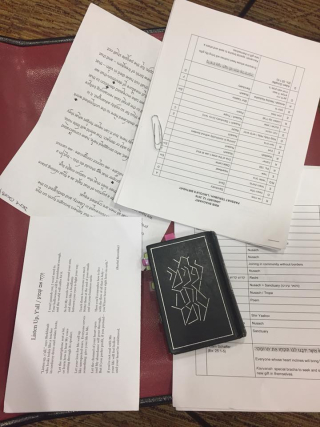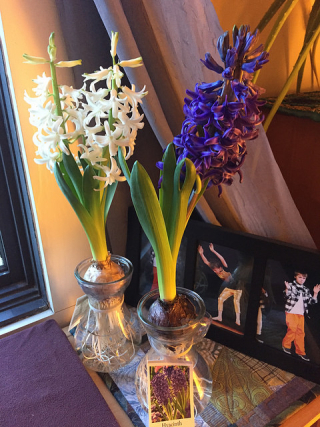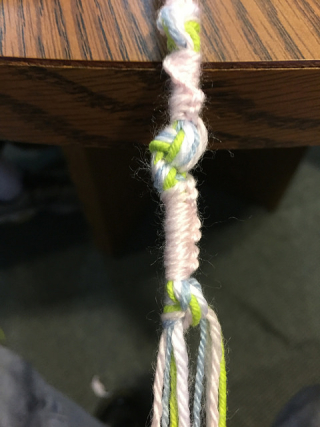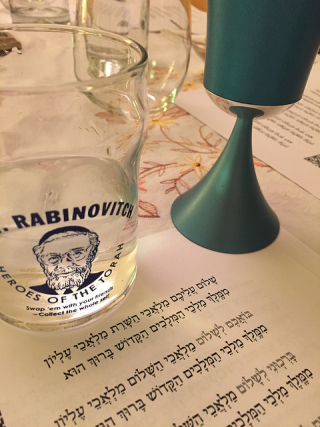Rachel Barenblat's Blog, page 78
February 14, 2018
Joyful Life As A Religious Minority - on Reports from the Spiritual Frontier
I was interviewed recently for the podcast Reports from the Spiritual Frontier. My episode is live now, and the host -- my friend and colleague Ben Yosua-Davis -- titled it "Joyful Life As A Religious Minority." Here's what he wrote about it:
Join us for a conversation with Rachel Barenblat, Co-Founder of Bayit: Your Jewish Home, blogger at Velveteen Rabbi, and Rabbi at Congregation Beth Israel in North Adams, MA, as we talk about her experience of life as a religious minority. Hear about the gift of oddity, (9:30) the challenges and joys of being a religious minority (8:30), a more life-giving way to speak into Christian anxieties about Sunday sports, graying populations, and declining worship attendance, (15:00) and what it means to let new generations shape the tradition with their own hands (25:00). Hear more from Rabbi Rachel and other spiritual innovators by visiting us at www.facebook.com/reportsfromthespirit... or by subscribing to us via Apple Podcasts, Google Podcasts, or wherever else you acquire your best listens for your week.
On Facebook he added:
Three reasons why you should listen[...]:
1) She's a calm, deeply grounded presence. If you're panicked about all the change going on in our country right now, she'll help you take a deep breath.
2) If you're particularly anxious about Christian institutional decline, she speaks specifically to our concerns about: worship attendance, money, and graying congregations.
3) If you want a look at how a non-Christian tradition is teaching its young people to "shape the tradition with their own hands."
I'm deeply grateful to Ben for the opportunity and for the fabulous conversation!
Listen to the podcast here: Rachel Barenblat: Joyful Life As A Religious Minority. (He'll be posting a "B-side" mini-podcast on Thursday, featuring two of my poems from my new collection Texts to the Holy, too.) And here are all of the episodes.

February 12, 2018
Gifts from this year's Rabbis Without Borders retreat
 The first night of this year's Rabbis Without Borders alumni fellows gathering opens with a jam-session-style ma'ariv (evening service). Rabbi Ben Newman of Shtiebl has assembled a set of songs that fit the evening service -- sometimes using English words, often using secular melodies.
The first night of this year's Rabbis Without Borders alumni fellows gathering opens with a jam-session-style ma'ariv (evening service). Rabbi Ben Newman of Shtiebl has assembled a set of songs that fit the evening service -- sometimes using English words, often using secular melodies.
(For instance, for our ma'ariv aravim / God-who-brings-on-the-evening prayer, he's set words about evening and transition to the melody of "Good Night, Irene." When people figure out what melody he's chosen, a ripple of satisfaction and laughter flows around the room.) There are a handful of guitars, a tenor ukelele, a djembe, some tambourines, and a couple dozen rabbis singing with gusto. What a glorious way to start the retreat!
The next morning I get to co-lead davenen with Rabbi David Markus and Rabbi Evan Krame, two of my Bayit co-founders. Rabbi Evan offers his beautiful singable ashrei variation composed of alphabetical quotes from His Holiness the Dalai Lama. Rabbi David offers the Gettysburg Address in haftarah trope because it's Lincoln's birthday. I offer Listen Up, Y'all, which I wrote for a service I co-led here two years ago at this retreat. We interweave nusach (the weekday melody-system) with melodies. We sing in harmony. I come away beaming.
This is one of the things I love most about gatherings like this one: the opportunity to daven with people who care about these words as much as I do. (Not to mention the opportunity to sing in harmony with friends, which is one of the most emotionally and spiritually satisfying things in the world for me.) I lead davenen regularly at my synagogue, and I always get some good "juice" from praying, but there's nothing quite like davening with friends in harmony while relaxing into the way the words and melodies and shared intentions can buoy me.
About half of the programming this year is provided for us / by us -- sessions on the things we're doing, or our areas of expertise, or various forms of self-care for rabbis. My Bayit co-founders and I offer a session on what we're doing and how we hope our RWB colleagues will partner with us. I attend a terrific session on the tension between pursuing social justice and ministering to a politically diverse congregation, and another on mysticism, shamanism, and folk practices (from angels to hamsas to amulets), and another on experiential pluralism through the lens of complementary flavors.
During our plenary sessions (the theme is "Leading in Challenging Times") we hear from Dr. Connor Wood of Faith In Depth, about conservatism and liberalism and how they play out in the religious sphere. We hear from Rev. Dr. Derrick Harkins about vocation, balancing the pastoral and the prophetic, and being a religious leader during turbulent times. We break into small groups and discuss pluralism, how we invest our stories with meaning, where and how we build bridges and where and how we draw our lines. Both speakers are good, though honestly I'm here more for the hevreschaft (collegiality / friendship) than for expert speakers.
And the hevreschaft is sweet and satisfying and enriching b'chol olamot (on all levels). Really what draws me here are the conversations: at mealtimes, on couches in the hallways, over coffee in the morning and other beverages once night falls. We talk about life and relationships and transitions and spiritual practice and texts and Torah -- about what we're reading, how we're davening, what brings us joy in our work -- about innovation and pluralism and the cutting edge of spiritual life and what real spiritual R&D might be. This is what I'm thirsty for, in the ordinary sometimes-isolation of serving a congregational community solo, and I drink it up like a happy plant receiving longed-for rain.
When the time comes for me to take my leave of everyone (a bit early -- before the retreat has officially ended, alas) I'm sorry to go... but grateful to have had this opportunity to replenish mind, heart, and spirit with colleagues who care about spiritual life, innovation, and the Jewish future in some of the same ways that I do.

February 11, 2018
Off to Rabbis Without Borders (again)
 I'm off today to Pearlstone for the annual alumni gathering of Rabbis Without Borders fellows. As always, I'm looking forward to reconnecting with colleagues and friends across the denominational (and trans-denominational) spectrum.
I'm off today to Pearlstone for the annual alumni gathering of Rabbis Without Borders fellows. As always, I'm looking forward to reconnecting with colleagues and friends across the denominational (and trans-denominational) spectrum.
This year we'll be hearing from guest speakers in the morning, on questions of political pluralism and how it interfaces with spiritual pluralism, and the afternoon sessions will be led by us.
On Monday I'll be co-leading morning davenen (prayer) with Rabbi David Markus and Rabbi Evan Krame, and at lunch we'll be sharing with our colleagues about Bayit: Your Jewish Home and opportunities for collaboration between Bayit and RWB.
I'm looking forward to good conversations, meaningful davenen, and coming home rejuvenated from time spent with others who care about spiritual life, innovation, and the Jewish future as much as I do.

February 7, 2018
On building and making our tradition our own
...The Talmud draws a connection between children and builders. (The connection relies on a Hebrew pun between two words that sound almost the same.) All of us are tradition’s children, inheritors of richness from those who came before us. And all of us can be tradition’s builders. We have the opportunity (maybe even the obligation) to take up our tools and build the Judaism that the future most needs...
That's from my latest essay for The Wisdom Daily, on building and making our tradition our own, written in honor of my Bayit co-founders. Read the whole thing: Why Judaism Feels Like Home To Me.

February 5, 2018
February: turning toward the light
 February can be a tough month. The Jewish spiritual calendar says we've taken our first steps toward the rising sap of spring, but the rising sap -- both literal and metaphorical -- is invisible to the human eye.
February can be a tough month. The Jewish spiritual calendar says we've taken our first steps toward the rising sap of spring, but the rising sap -- both literal and metaphorical -- is invisible to the human eye.
In New England where I make my home, we're entrenched in snow and rain and ice. The days are growing longer, but the world is still cold. My windshield is still obscured with its seasonal scrim of road salt. Winter won't unclench for a while yet.
I've been taking comfort from the pair of hyacinth bulbs in my bedroom window. They were a gift from a friend a few weeks ago, and when I received them they were plain bulbs with root fronds below and only the tiniest nubs of green on top.
But within days they shot up, green leaves yearning toward the sun. And then they bloomed. Oh, their blooms! I've been under the weather for a few weeks now, but even so I can smell their fragrance, and it awes me.
Reb Zalman z"l used to say that as plants are heliotropic -- they naturally turn toward the sun -- we human beings are theotropic. It's in our nature to "grow toward God," to turn toward the source of light that enlivens us.
As plants draw sustenance from (soil and water and) the rays of the sun, we draw sustenance from a more metaphorical kind of light. We draw sustenance from the "light" of love and hope and connection.
What do you need to turn toward, as we move deeper into this season? What enlivens you and lifts your heart? What gives you a sense of hope? What would it feel like to turn toward those things, and ride that updraft all the way into spring?

February 2, 2018
In the tradition of Rumi...
The incomparable @velveteenrabbi has a new book of poems out, in the tradition of Rumi, Yehuda HaLevi, and Elazar ben Moshe Azikri. Get yours: https://t.co/W9QHyslxmx pic.twitter.com/seTiujkujN
— Rabbi Danya Ruttenberg (@TheRaDR) February 1, 2018
I'm proofing the pre-publication galley copy of my next book, Texts to the Holy, due soon from Ben Yehuda Press. (Pre-order a copy now!) Deep thanks to Rabbi Danya Ruttenberg for these kind words.
Shabbat shalom to all!

January 30, 2018
Once more, with pigment
 Tying tzitzit has become one of my favorite mitzvot. It's funny to remember that a mere four years ago the practice was new to me. I learned how to tie tzitzit in order to try out the mitzvah of wearing a tallit katan, the "small tallit" that some Jews wear in order to fulfill the mitzvah (connective-commandment) of wearing tzitzit, fringes, on the corners of our garments.
Tying tzitzit has become one of my favorite mitzvot. It's funny to remember that a mere four years ago the practice was new to me. I learned how to tie tzitzit in order to try out the mitzvah of wearing a tallit katan, the "small tallit" that some Jews wear in order to fulfill the mitzvah (connective-commandment) of wearing tzitzit, fringes, on the corners of our garments.
I tried out the mitzvah myself in order to feel good about asking my students to do so, too. In those days I taught the fifth through seventh grade class at my shul. I wanted my students to learn how to tie tzitzit and to have the experience of wearing them, but they weren't yet old enough to take on the mitzvah of tallit gadol, the "big tallit" that adult Jews wear to pray.
In some shuls, tallit gadol is worn by kids of any age when they come up to the bimah to lead a prayer or song, but in my community the minhag -- custom -- is for tallit gadol to be formally taken on at b'nei mitzvah time as part of taking on an "adult" relationship with mitzvot. So we made tallit katan, and everyone tried it out and shared what it was like. (Here's the post I wrote then, about making my own tallit katan, and trying the mitzvah myself before assigning it to my students: String theory.)
In more recent years, the seventh graders have designed and decorated tallit gadol, a process that culminates in tying on the fringes that make it a ritual garment. But this year I'm working again with kids who have some time before their celebrations... so this year's "tallisareum" (a term I borrowed from Reb Zalman z"l) is a tallit-katan-making enterprise again.
In the years since I first learned to tie tzitzit in order to teach my students, I've learned Reb Zalman's mode of tying tzitzit, with the spiraling knots that make a diagonal line down the rows of seven and eight and eleven and thirteen knots. And I've learned more about different customs around colorful tzitzit.
The text from Torah that instructs us to wear tzitzit also instructs us to include a thread of blue. I asked my students what they thought that might represent. Their first thoughts were "sky" and "sea," which turn out to be exactly right: the blue represents the water of the sea, which represents the sapphire of the sky, which represents the sparkling floor described in Torah beneath the divine throne. (Actually Torah says it was like a sapphire floor, but not actually a sapphire floor. Nava Tehila wrote a beautiful setting for that verse. In any event, the blue reminds us of sea and sky and God.)
I've also seen the custom of including a green thread among the fringes on one's tzitzit. I asked them what they thought that might represent, and they suggested green growing things. Right again: the green thread is aimed at reminding us of our obligation to care for the environment. (I learned that from Rabbi Hanna Tiferet some years ago.) That seems particularly appropriate this week as we approach Tu BiShvat, the New Year of the Trees, a festival that reminds us to care for the earth.
And finally there's the custom of including pink and blue threads, representing the pink and blue colors of the transgender flag -- a reminder that we are all created in the Divine image regardless of gender or gender expression; a reminder of our obligation to treat people of all genders with kindness and respect. I learned that from my friend, teacher, and Bayit co-founder Rabbi Mike Moskowitz (you can see a photo of his beautiful trans inclusion tzitzit on his website.)
When my students tied their tzitzit on their tallit katan this year, each of them chose a different combination of threads. Some wanted trans inclusion colors. Some wanted earth / environment awareness colors. Some wanted the darker blue of the sea and sky. I love that they all made their own choices about what they want their fringes to remind them: not just that they are Jews, not just of the mitzvot writ large, but specific mitzvot of creation care and trans inclusion and remembrance of the Holy.
The assignment, once the tzitzit are tied, is the same as ever: wear it at least once, and report back on what it was like. Each student can make their own choice about whether or not to visibly display their fringes. (Based on what previous classes have reported, the experience of walking around for a day with tzitzit on is a consciousness-raiser even if the fringes are tucked in.) I can't wait to hear what they teach me about whether and how their color choices impact their experience of this mitzvah.

January 28, 2018
Building together, and the rotating rebbe chair
 When the seven of us came together to form Bayit, we brainstormed not only the kinds of projects we want to take on, but also the kinds of structures we need to build in order to support the work. Our bylaws offer a governance structure that's not quite like anything else I've experienced elsewhere, and I'm super-excited about it (because yes, I'm the kind of geek who gets excited about nonprofit governance!) It also feels emblematic of much that we hope to do and be.
When the seven of us came together to form Bayit, we brainstormed not only the kinds of projects we want to take on, but also the kinds of structures we need to build in order to support the work. Our bylaws offer a governance structure that's not quite like anything else I've experienced elsewhere, and I'm super-excited about it (because yes, I'm the kind of geek who gets excited about nonprofit governance!) It also feels emblematic of much that we hope to do and be.
Bayit has seven Founding Builders. At any given time, we have a board chair and vice-chair, as is standard on most boards of directors. We also have a secretary and a treasurer, and an ethics chair who leads our ethics committee, and those latter three roles last for a year. But the chair and vice-chair roles will rotate quarterly. We all get a turn.
At our December Senior Builder meeting we picked a first board chair, and the next person down the alphabet gets to be our first vice chair. In late March, the vice chair will become chair, the next person in line gets to be vice chair, and the first chair gets to be a regular founding builder like everyone else. It's also built into our bylaws that anyone who wants to do so can "pass," so no one is obligated to serve in the chair or vice-chair role if it's not a good time for them to take that role on. But everyone is entitled to a turn. Serving as board chair is something each of us gets the opportunity to do.
Bayit's founding philosophy is that we're all builders. That's core to our vision, both within the organization (in how the seven founding builders relate to each other, and to the other folks who collaborate and build with us) and in the organization's relationship with those who (we hope) will embrace and use and adapt and respond to the resources we'll provide. We want to live our values and to model mutual empowerment and healthy collaboration. As we rotate board roles, we each get the opportunity to grow in different ways, and to collectively take responsibility for balancing our skill-sets and energetics around the board table and across the organization.
 We made this choice with loving awareness of one of the stories people like to tell about Reb Zalman z"l, the teacher of my teachers: the story of the rebbe chair and the Shabbes tisch. (I've told this one before, but it's worth sharing again.) Reb Zalman used to hold a regular "tisch" on Shabbat. A tisch (טיש) is a festive gathering around the table, often featuring food and a l'chaim (a toast) and singing and hearing the rebbe give over some Torah.
We made this choice with loving awareness of one of the stories people like to tell about Reb Zalman z"l, the teacher of my teachers: the story of the rebbe chair and the Shabbes tisch. (I've told this one before, but it's worth sharing again.) Reb Zalman used to hold a regular "tisch" on Shabbat. A tisch (טיש) is a festive gathering around the table, often featuring food and a l'chaim (a toast) and singing and hearing the rebbe give over some Torah.
At the beginning of the tisch, he'd be sitting in the "rebbe chair" at the head of the table. And when he was done teaching, he'd ask everyone to rise, and all move over one seat, and whoever was then in the rebbe seat became the rebbe, and whatever they had to teach, the table received with the same attentiveness they had given to Reb Zalman. And so on, and so on, until everyone had had the opportunity to sit in the rebbe seat and to experience being in the rebbe role.
A rebbe, taught Reb Zalman z"l, doesn't have to be a singular individual in a position of power. Rebbe can be a role we fullfil for each other, a role into which each person is nurtured and nourished to grow. The person "in the rebbe chair" isn't the permanent vertical top-down leader. The person occupying that leadership role is meant to be a fount of inspiration and collective guidance -- and that inspiration and guidance can, and should, and arguably must, come through each of us in turn. This means it's the job of each of us to honor our own rebbe spark -- and also to let it go so that the flow can come through others, too.
Each of us can be the rebbe, and can honor the rebbe spark in the others around the table. Each of us can be empowered to lead, and to support others in leadership. Each of us can be a builder of the Jewish future of which we dream. That's part of what I understand Reb Zalman's vision to have been, and that's the activating philosophy behind Bayit. So tell us: what do you want your Jewish future to be, and what tools do you need in order to bring that vision to life?

January 23, 2018
How to celebrate Tu BiShvat (and a renewed haggadah from Bayit)
 Tu BiShvat, the "new year of the trees," is coming at the very next full moon, the night of January 30. If you'd like to celebrate Tu BiShvat at home with friends or family, it's easy to do -- and it's a beautiful holiday that can open the heart to growth, renewal, and sweetness. Here's what you need:
Tu BiShvat, the "new year of the trees," is coming at the very next full moon, the night of January 30. If you'd like to celebrate Tu BiShvat at home with friends or family, it's easy to do -- and it's a beautiful holiday that can open the heart to growth, renewal, and sweetness. Here's what you need:
1) Tree fruits. Ideally, you need at least one fruit in each of the following categories:
tree fruit with an inedible shell (e.g. oranges, bananas, nuts, coconut)
tree fruit with a pit or seed (cherries, plums, apricots, olives)
tree fruit that's edible all the way through (figs, mulberries, apples, pears)
You can use fresh fruits, or dried. You can have one fruit in each category, or several. You can opt to try a new fruit that you've never had before, and say the shehecheyanu for trying something new. This can be as simple or as elaborate as you want.
Some also have a custom of sipping a nip of either maple syrup, or etrog vodka, at a certain point in the seder. If either one of those appeals to you and is accessible to you, lay in a supply of that as well.
2) Grape juice or wine, both white and red. You'll need enough for four symbolic cups: one white, one white with a bit of red in it, one red with a bit of white in it, and one red. (Since you'll be mixing the liquids to create different colors in the glass, I don't recommend using expensive wine or juice for this purpose, but that too is up to you.)
3) A haggadah that will walk you through experiencing the four worlds and consuming the symbolic tree fruits and wines / juices that facilitate each step on the journey.
There are a ton of haggadot for Tu BiShvat online, and I've shared several here over the years. Here's the one I'll be using this year, co-created by myself and my fellow Bayit co-founder Rabbi David Markus (it's an update of the one we created and shared a few years ago):
Tu BiShvat Haggadah 5778 from Rachel Barenblat
It's a digital slide show, intended to be projected on a screen. If you'll be a small group around a small table, you could just page through the slides on your laptop.
That's all you need! If you want to be minimalist: three pieces of tree fruit, two bottles of juice, and a haggadah. If you want to be maximalist, you can arrange a table laden with tree fruits and even decorations: bare branches representing winter, leafed-out branches from the florist, photographs of trees, whatever calls to your heart.
Living as I do in a place where this time of year is deepest midwinter, I've come to love this holiday as a first step toward the coming of spring. I hope you'll explore Tu BiShvat and see what it opens up for you, emotionally and spiritually. If you do use our haggadah, let us know what works for you and what doesn't -- we're eager to hear. Leave a comment at the Bayit Facebook page or ping us @yourbayit on Twitter and let us know your thoughts!
You can also find this haggadah archived on the Spiritual Resources page at Bayit.

The gift of an immersive Shabbat
 When I started teaching my Journey Into Judaism class, I knew what experience I most wanted to give my students: an immersive Shabbat.
When I started teaching my Journey Into Judaism class, I knew what experience I most wanted to give my students: an immersive Shabbat.
The texture of time shifts over the course of the day. There's the anticipatory energy of Friday night (welcoming Shabbat into our midst like an eagerly-anticipated guest), which is different from the settling-in of Shabbat morning, which is different from a leisurely Shabbes afternoon, which is different from the aching, yearning tenor of Shabbat mincha-time, which is different from havdalah as evening falls.
I wondered: would my students be willing to commit to spending an entire Shabbat together? We could begin with Friday night dinner around my table. Continue with Shabbat morning davenen at the synagogue. And then stay at shul for lunch, and spend the afternoon together, and close the day with havdalah. If we did it during the wintertime, havdalah would come relatively early in the day. The more I thought about it, the more excited I became.
So I floated the idea to my students, braced for the likelihood that the idea might not go far. We'd read Heschel's The Sabbath, and Heschel writes gloriously about Shabbat as a palace in time -- but it's a far cry between reading his elegant prose, and committing to giving up 25 hours of precious weekend time for an experience no one in the room had ever actually had before. And even if they were potentially interested in the idea, what were the odds of managing to get seven household schedules to align? To my delight, every one of my students agreed that this was worth trying to do.
We met in my condo on a Friday night. I set as beautiful a Shabbes table as I know how, with the embroidered white tablecloth given to me by Russian friends many years ago, and my usual Shabbat candlesticks and kiddush cup and challah cover. I added a vase of tulips, a sign of yearned-for spring. When everyone arrived we sang Shalom Aleichem to welcome the angels of Shabbat. We blessed candles and wine, bread and the children. (To my great delight, my son asked why there were two challot -- usually we have only one, since we're a small household -- so I got to teach about the double portion of manna that fell on Shabbat!)
The kids ate grilled cheese sandwiches, and watched favorite cartoons, and played games and with the cat. The adults ate soup and quiche, and drank wine, and talked and laughed and enjoyed one another's company. Sometimes our conversation was silly and sometimes it was serious. Over the course of dinner, conversation topics around the table ranged from funny kid stories to talk about God and spiritual practice. We ate ice cream with raspberries. We closed the meal with brich rachamana. I went upstairs to put my son to bed, and by the time I came down my dishwasher was running merrily and my kitchen was clean.
On Shabbat morning we regrouped for morning services, along with the other folks who came to shul. We feasted on a gorgeous, leisurely potluck lunch, with spacious time for relaxing and even enjoying dessert. I taught a class on God, which began with harvesting the room's questions about God, and continued with conversation about R' Brent Spodek's beautiful sermon I (don't) believe in God, and about different names of / faces of God (which ones resonate for us, and which ones don't, and why), and learning about the four worlds and how the God we think about may be different from the God to whom we yearn to relate.
Maggid David Arfa taught a beautiful class on Rabbi Abraham Joshua Heschel and environmentalist Rachel Carson and wonder. He brought a variety of short texts (from Rabbi Heschel, and from the tradition writ large -- I especially loved the one from R' Moshe Cordovero about how even a stone contains divinity.) And then we looked closely at a Rachel Carson article and an excerpt from Heschel's work and talked about cultivating awe as a core quality of spiritual practice, and whether awe is enough or whether it's meant to call us into action and relationship, and about what brings us closer to feelings of awe and wonder.
Two of my congregants led a session on different forms of Jewish contemplative practice. One of the practices they offered was a guided meditation that began by urging us to give ourselves the gift of this time during which we can release ourselves from the perceived obligations to "do" things, and instead simply be. Afterward we talked about how that, right there, is the essence of Shabbat. The shift from doing to being (and having that be "enough," rather than the constant striving to accomplish and produce) is what makes Shabbat radical, what makes it meaningful, what makes it a transformative spiritual practice in itself.
As the light of the afternoon waned, I led a session on eit ratzon / time of yearning, featuring niggunim and poetry and teachings about the special emotional and spiritual qualities of the end of Shabbat. I shared teachings about how God's yearning for us and for relationship with us preceded the act of creation itself -- and since creation (tradition teaches) began at sundown preceding the first day, Shabbat afternoon is the time when we and God may most deeply feel our yearning for each other. We sang. I read poems. We spoke about the things we wanted to carry with us from this special day. And then we made havdalah.
My students thanked me afterwards for the gift of a full Shabbat. I don't know whether they understand the extent to which their participation was a gift for me. I know what a whole Shabbat can feel like -- the way time liquefies and changes, the way the heart and soul soften and open -- but most of the time I don't get to live into that experience. Most of the time I don't get the luxury of a full Shabbat, a whole Shabbat that stretches mindfully from sundown to sundown. And most of the time I don't get to have the experience of immersing in a full Shabbat with others who are open to how the flow of Shabbes can open the heart.
I'm intensely grateful to my students and my congregants for their willingness to take the plunge and give themselves over to Shabbat from start to finish... and I'm delighted that people are already starting to brainstorm about how we can do it again! Unlike our other holidays, Shabbat is a transformative experience open to us every single week. I hope this will turn out to be not the only immersive Shabbaton to take place at my shul, but rather merely the first... and that those who so generously gave themselves over to the experience will come back to do it again, and bring others along with them for the ride next time.

Rachel Barenblat's Blog
- Rachel Barenblat's profile
- 6 followers



